Revisiting the Value of Various Ecosystems: Considering Spatiality and Disaster Concern
Abstract
:1. Introduction
1.1. Disaster Prevention and Mitigation Functions of Ecosystem Services
1.2. Spatial Heterogeneity
2. Materials and Methods
2.1. Data Description
2.2. Description of the Study Area
2.3. Empirical Model
3. Results and Discussion
3.1. Descriptive Statistics
- The selection of a low-risk residence due to the presence of disaster concerns.
- The selection of a high-risk residence despite the presence of concerns.
- The set of results of continuing to live in high-risk residences after experiencing the disaster because they did not have the opportunity to choose their residences.
3.2. Regression Results and Discussion
4. Conclusions
- Re-examine the importance of incorporating spatial variables, considered in previous studies, into a function representing the benefits people receive from various ecosystems.
- Investigate the appropriateness of integrating ecosystem use and nonuse values and disaster prevention and mitigation functions into a function representing the benefits people receive from ecosystems.
- Construct a concept representing ecosystems’ perceived disaster prevention and mitigation functions based on the results.
Supplementary Materials
Author Contributions
Funding
Institutional Review Board Statement
Informed Consent Statement
Data Availability Statement
Acknowledgments
Conflicts of Interest
References
- Managi, S.; Kumar, P. Inclusive Wealth Report 2018, 1st ed.; Routledge: Oxfordshire, UK, 2018. [Google Scholar]
- Markhvida, M.; Walsh, B.; Hallegatte, S.; Baker, J. Quantification of disaster impacts through household well-being losses. Nat. Sustain. 2020, 3, 538–547. [Google Scholar] [CrossRef]
- Orimoloye, I.; Zhou, L.; Kalumba, A.M. Drought Disaster Risk Adaptation through Ecosystem Services-Based Solutions: Way Forward for South Africa. Sustainability 2021, 13, 4132. [Google Scholar] [CrossRef]
- Morris, R.L.; Konlechner, T.M.; Ghisalberti, M.; Swearer, S.E. From grey to green: Efficacy of eco-engineering solutions for nature-based coastal defence. Glob. Chang. Biol. 2018, 24, 1827–1842. [Google Scholar] [CrossRef]
- Williams, D.S.; Costa, M.M.; Sutherland, C.; Celliers, L.; Scheffran, J. Vulnerability of informal settlements in the context of rapid urbanization and climate change. Environ. Urban. 2018, 31, 157–176. [Google Scholar] [CrossRef]
- Ozturk, U.; Bozzolan, E.; Holcombe, E.A.; Shukla, R.; Pianosi, F.; Wagener, T. How climate change and unplanned urban sprawl bring more landslides. Nature 2022, 608, 262–265. [Google Scholar] [CrossRef]
- Daniel, T.C.; Muhar, A.; Arnberger, A.; Aznar, O.; Boyd, J.W.; Chan, K.M.A.; Costanza, R.; Elmqvist, T.; Flint, C.G.; Gobster, P.H.; et al. Contributions of cultural services to the ecosystem services agenda. Proc. Natl. Acad. Sci. USA 2012, 109, 8812–8819. [Google Scholar] [CrossRef]
- Díaz, S.; Demissew, S.; Carabias, J.; Joly, C.; Lonsdale, M.; Ash, N.; Larigauderie, A.; Adhikari, J.R.; Arico, S.; Báldi, A.; et al. The IPBES Conceptual Framework—Connecting Nature and People. Curr. Opin. Environ. Sustain. 2015, 14, 1–16. [Google Scholar] [CrossRef]
- Guerry, A.D.; Polasky, S.; Lubchenco, J.; Chaplin-Kramer, R.; Daily, G.C.; Griffin, R.; Ruckelshaus, M.H.; Bateman, I.J.; Duraiappah, A.; Elmqvist, T.; et al. Natural capital and ecosystem services informing decisions: From promise to practice. Proc. Natl. Acad. Sci. USA 2015, 112, 7348–7355. [Google Scholar] [CrossRef]
- Sutherland, R.J.; Walsh, R.G. Effect of Distance on the Preservation Value of Water Quality. Land Econ. 1985, 61, 281–291. [Google Scholar] [CrossRef]
- Bateman, I.J. Bringing the real world into economic analyses of land use value: Incorporating spatial complexity. Land Use Policy 2009, 26, S30–S42. [Google Scholar] [CrossRef]
- Johnston, R.J.; Ramachandran, M.; Schultz, E.T.; Segerson, K.; Besedin, E.Y. Characterizing Spatial Pattern in Ecosystem Service Values When Distance Decay Doesn’t Apply: Choice Experiments and Local Indicators of Spatial. In Proceedings of the Agricultural and Applied Economics Association (AAEA) > Agricultural and Applied Economics Association (AAEA) Conferences 2011 Annual Meeting, Pittsburgh, PA, USA, 24–26 July 2011. [Google Scholar]
- Bockstael, N.E. Modeling Economics and Ecology: The Importance of a Spatial Perspective. Am. J. Agric. Econ. 1996, 78, 1168–1180. [Google Scholar] [CrossRef]
- Pate, J.; Loomis, J. The Effect of Distance on Willingness to Pay Values: A Case Study of Wetlands and Salmon in California. Ecol. Econ. 1997, 20, 199–207. [Google Scholar] [CrossRef]
- Bateman, I.J.; Ferrini, S.; Hime, S. Aquamoney: UK Case Study Report; CSERGE: Norwich, UK, 2008. [Google Scholar]
- Brouwer, R.; Martin-Ortega, J.; Berbel, J. Spatial Preference Heterogeneity: A Choice Experiment. Land Econ. 2010, 86, 552–568. [Google Scholar] [CrossRef]
- Bateman, I.J.; Day, B.H.; Georgiou, S.; Lake, I. The Aggregation of Environmental Benefit Values: Welfare Measures, Distance Decay and Total WTP. Ecol. Econ. 2006, 60, 450–460. [Google Scholar] [CrossRef]
- Schaafsma, M.; Brouwer, R.; Gilbert, A.; van den Bergh, J.; Wagtendonk, A. Estimation of Distance-Decay Functions to Account for Substitution and Spatial Heterogeneity in Stated Preference Research. Land Econ. 2013, 89, 514–537. [Google Scholar] [CrossRef]
- Reynaud, A.; Lanzanova, D. A Global Meta-Analysis of the Value of Ecosystem Services Provided by Lakes. Ecol. Econ. 2017, 137, 184–194. [Google Scholar] [CrossRef]
- Yoshimura, C.; Omura, T.; Furumai, H.; Tockner, K. Present state of rivers and streams in Japan. River Res. Appl. 2005, 21, 93–112. [Google Scholar] [CrossRef]
- Cabinet Office Japan. 2010 White Paper Disaster Management in Japan. Available online: https://www.bousai.go.jp/kaigirep/hakusho/h22/bousai2010/html/honbun/index.htm (accessed on 30 October 2022).
- Nakamura, K.; Tockner, K.; Amano, K. River and Wetland Restoration: Lessons from Japan. Bioscience 2006, 56, 419–429. [Google Scholar] [CrossRef]
- Katayama, N.; Baba, Y.G.; Kusumoto, Y.; Tanaka, K. A review of post-war changes in rice farming and biodiversity in Japan. Agric. Syst. 2015, 132, 73–84. [Google Scholar] [CrossRef]
- United Nations University. World Risk Report 2016. Available online: http://collections.unu.edu/view/UNU:5763#viewAttachments (accessed on 30 October 2022).
- Al Sawaf, M.B.; Kawanisi, K.; Xiao, C. Characterizing annual flood patterns variation using information and complexity indices. Sci. Total Environ. 2022, 806, 151382. [Google Scholar] [CrossRef]
- Ministry of Land Infrastructure Transport and Tourism. White Paper on Land, Infrastructure, Transport and Tourism in Japan; MLIT: Tokyo, Japan, 2012.
- Onday, O. Japan’s Society 5.0: Going Beyond Industry 4.0. Bus. Econ. J. 2019, 10, 1000389. [Google Scholar]
- Hanemann, W.M. The Economic Theory of WTP Valuing Environmental Preferences: Theory and Practice of the Contingent Valuation Method in the US, EU, and Developing Countries; Oxford University Press on Demand: Oxford, UK, 2001. [Google Scholar]
- Koundouri, P.; Kountouris, I.; Remoundou, K. Valuing a wind farm construction: A contingent valuation study in Greece. Energy Policy 2009, 37, 1939–1944. [Google Scholar] [CrossRef]
- Johnston, R.J.; Besedin, E.Y.; Wardwell, R.F. Modeling Relationships between Use and Nonuse Values for Surface Water Quality: A Meta-Analysis. Water Resour. Res. 2003, 39, 12. [Google Scholar] [CrossRef]
- Whitehead, J.C.; Carolina, N.; Blomquist, G.C. Measuring Contingent Values for Wetlands’ Effects of Information About Related Environmental Goods Information about Related Environmental Goods on Total of This Hypotheses about Willingness Indirectly through Use of Wetlands as an Activity Input with Eq. Water Resour. Res. 1991, 27, 2523–2531. [Google Scholar] [CrossRef]
- Jørgensen, S.L.; Olsen, S.B.; Ladenburg, J.; Martinsen, L.; Svenningsen, S.R.; Hasler, B. Spatially Induced Disparities in Users’ and Non-Users’ WTP for Water Quality Improvements-Testing the Effect of Multiple Substitutes and Distance Decay. Ecol. Econ. 2013, 92, 58–66. [Google Scholar] [CrossRef]
- Klaiber, H.A.; Phaneuf, D.J. Do Sorting and Heterogeneity Matter for Open Space Policy Analysis? An Empirical Comparison of Hedonic and Sorting Models. Am. J. Agric. Econ. 2009, 91, 1312–1318. [Google Scholar] [CrossRef]
- Baerenklau, K.A. A Latent Class Approach to Modeling Endogenous Spatial Sorting in Zonal Recreation Demand Models. Land Econ. 2010, 86, 800–816. [Google Scholar] [CrossRef]
- Information about Tsunami and Storm Surge. Available online: https://www.mlit.go.jp/river/kaigan/ (accessed on 6 February 2023).
- Majd, P.M.; Torani, S.; Maroufi, S.S.; Dowlati, M.; Sheikhi, R.A. The importance of education on disasters and emergencies: A review article. J. Educ. Health Promot. 2019, 8, 85. [Google Scholar] [CrossRef]
- Kousky, C. The role of natural disaster insurance in recovery and risk reduction. Annu. Rev. Resour. Econ. 2019, 11, 399–418. [Google Scholar] [CrossRef]
- Antronico, L.; Coscarelli, R.; De Pascale, F.; Condino, F. Social Perception of Geo-Hydrological Risk in the Context of Urban Disaster Risk Reduction: A Comparison between Experts and Population in an Area of Southern Italy. Sustainability 2019, 11, 2061. [Google Scholar] [CrossRef]
- Urdan, T.; Kaplan, A. The origins, evolution, and future directions of achievement goal theory. Contemp. Educ. Psychol. 2020, 61, 101862. [Google Scholar] [CrossRef]
- Ainscough, J.; Lentsch, A.D.V.; Metzger, M.; Rounsevell, M.; Schröter, M.; Delbaere, B.; de Groot, R.; Staes, J. Navigating pluralism: Understanding perceptions of the ecosystem services concept. Ecosyst. Serv. 2019, 36, 100892. [Google Scholar] [CrossRef]
- Dasgupta, S. The Economics of Biodiversity: The Dasgupta Review; Hm Treasury: London, UK, 2021.
- Quevedo, J.M.D.; Uchiyama, Y.; Kohsaka, R. Perceptions of local communities on mangrove forests, their services and management: Implications for Eco-DRR and blue carbon management for Eastern Samar, Philippines. J. For. Res. 2019, 25, 1–11. [Google Scholar] [CrossRef]
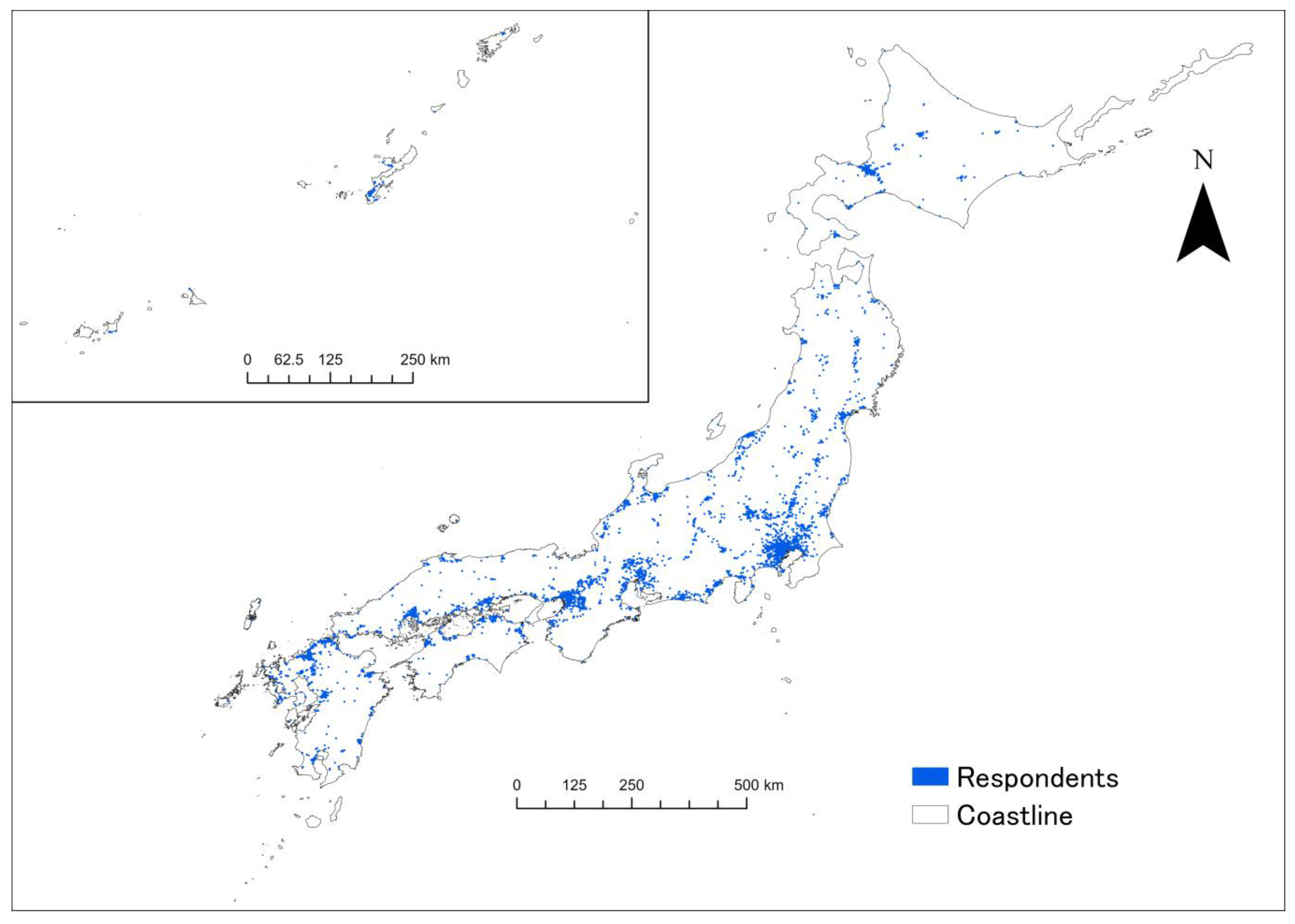

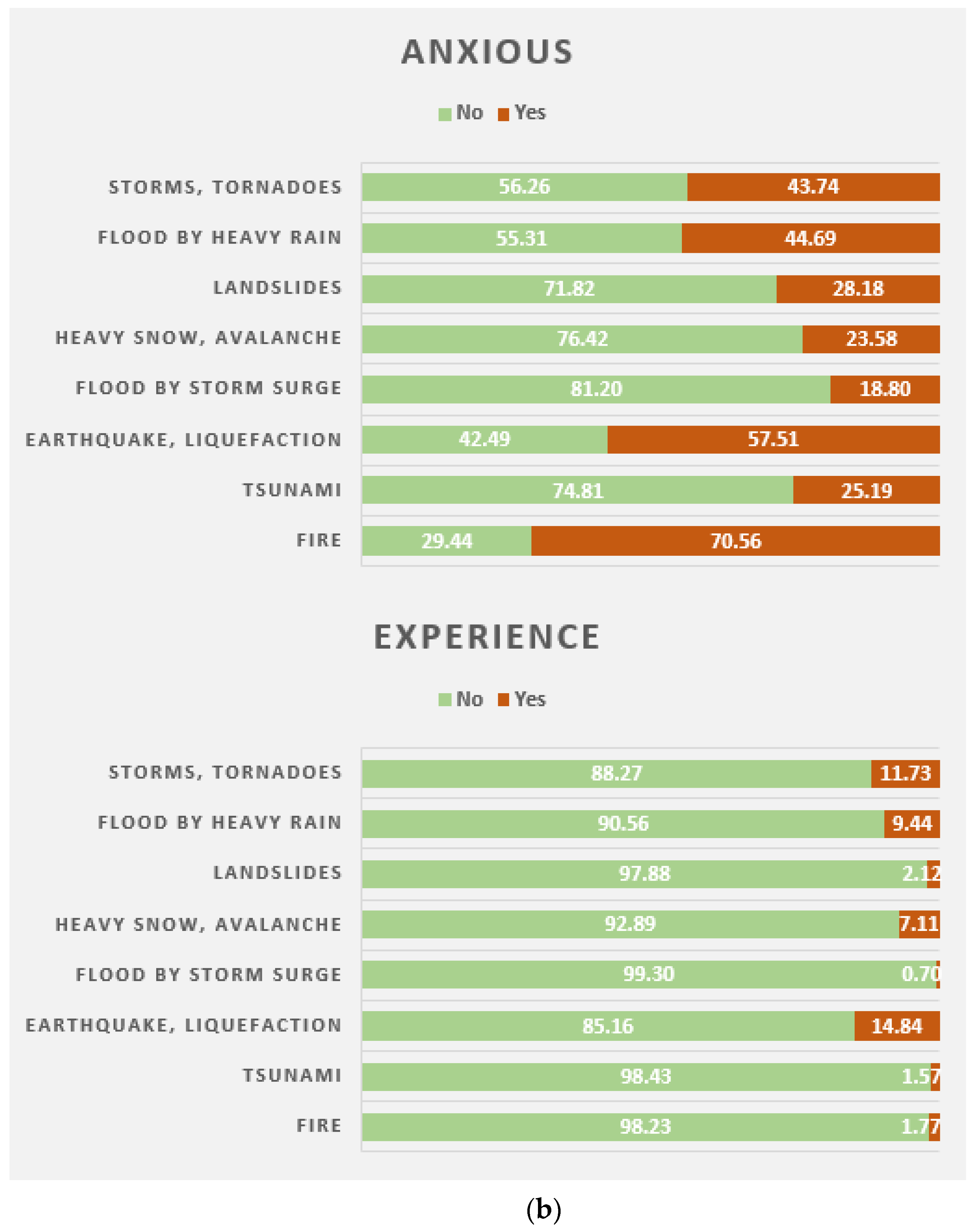
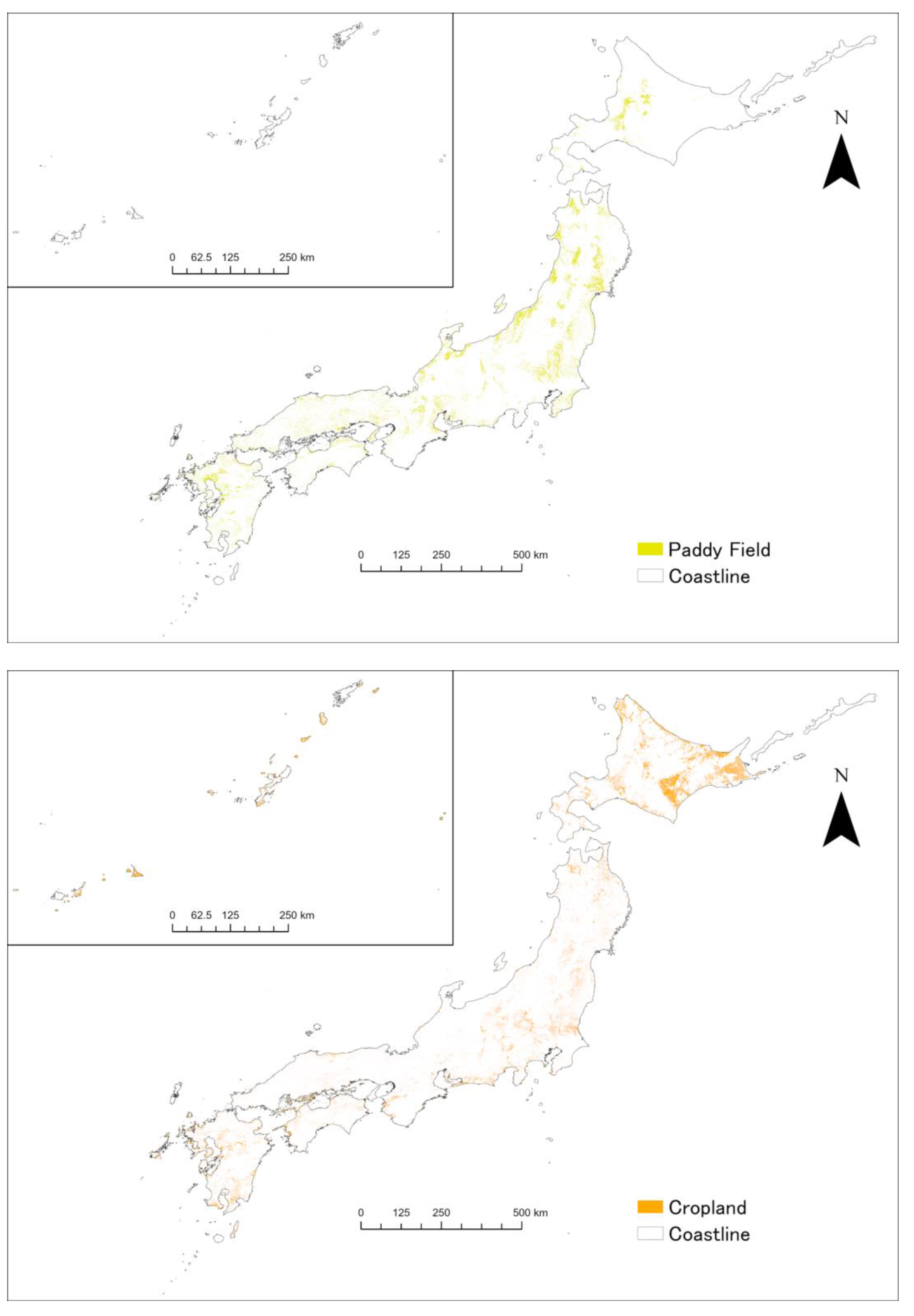
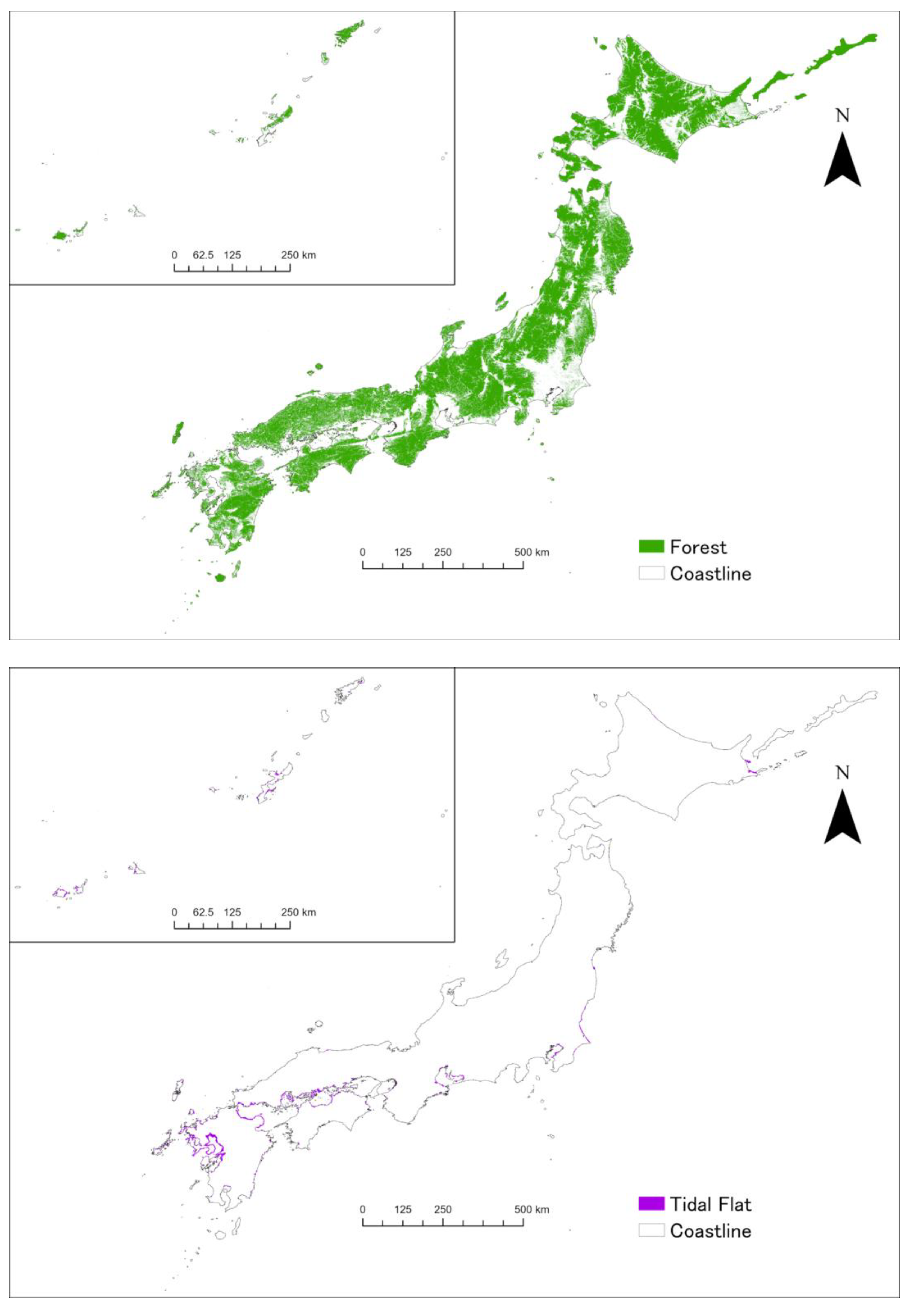
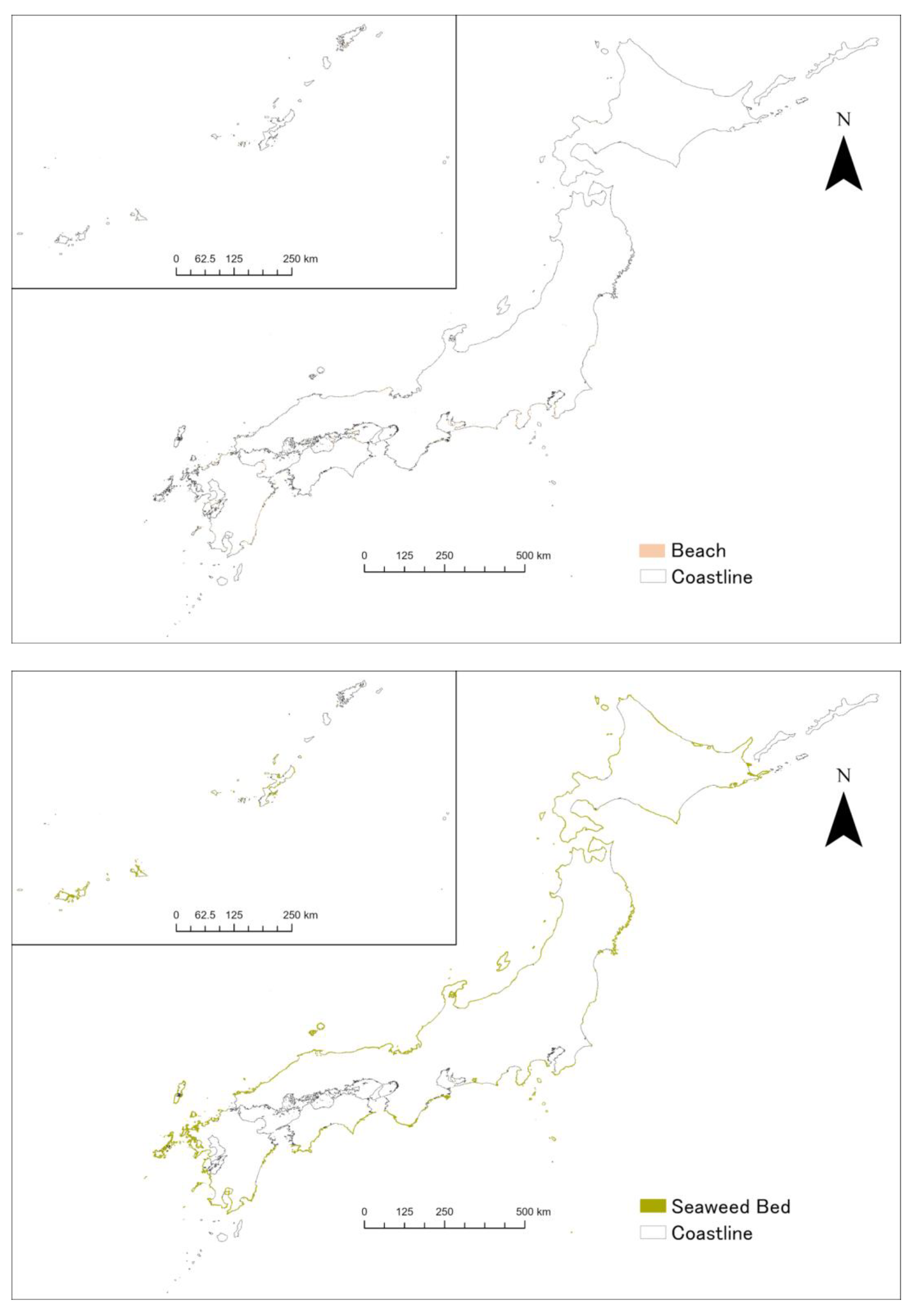
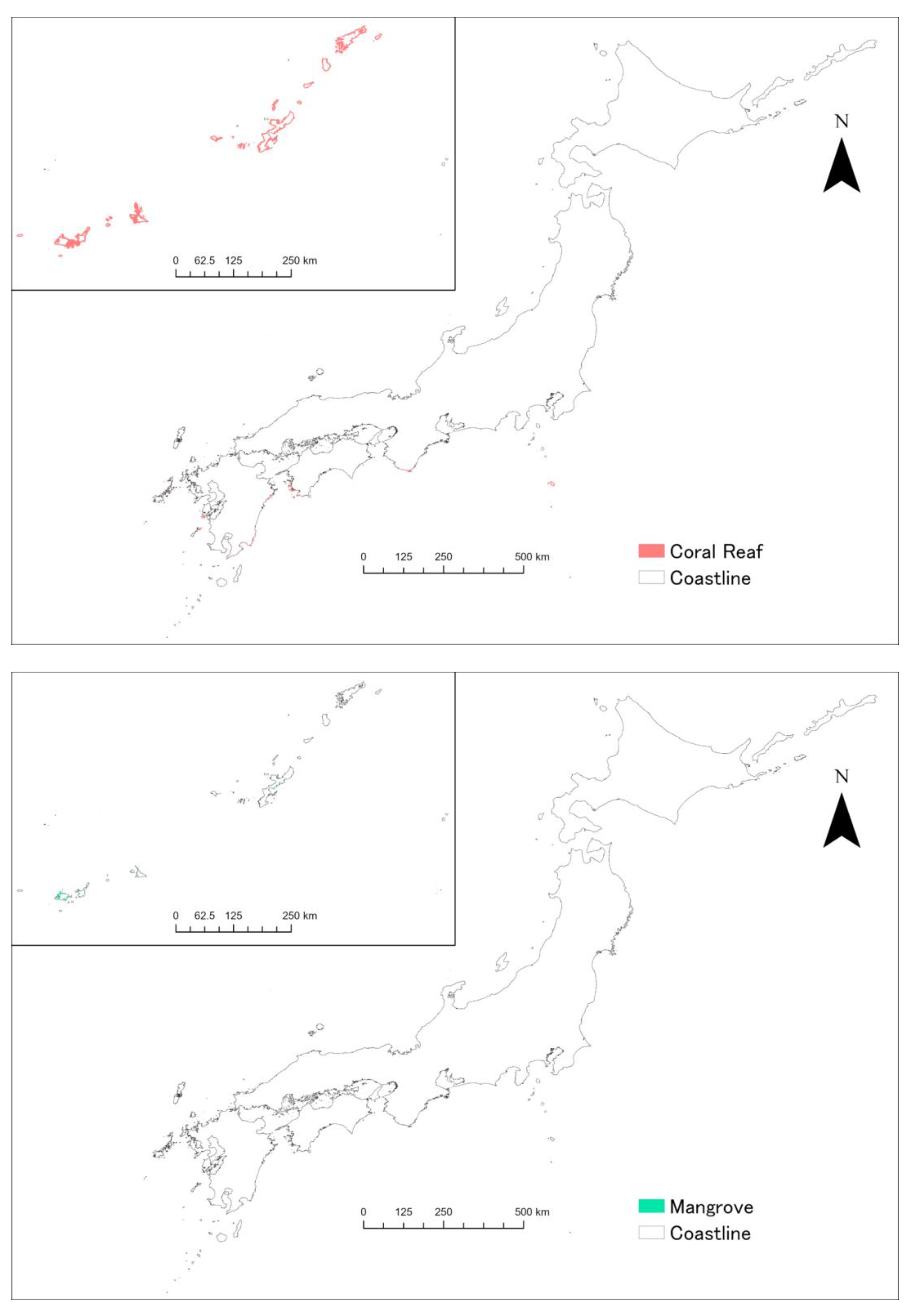
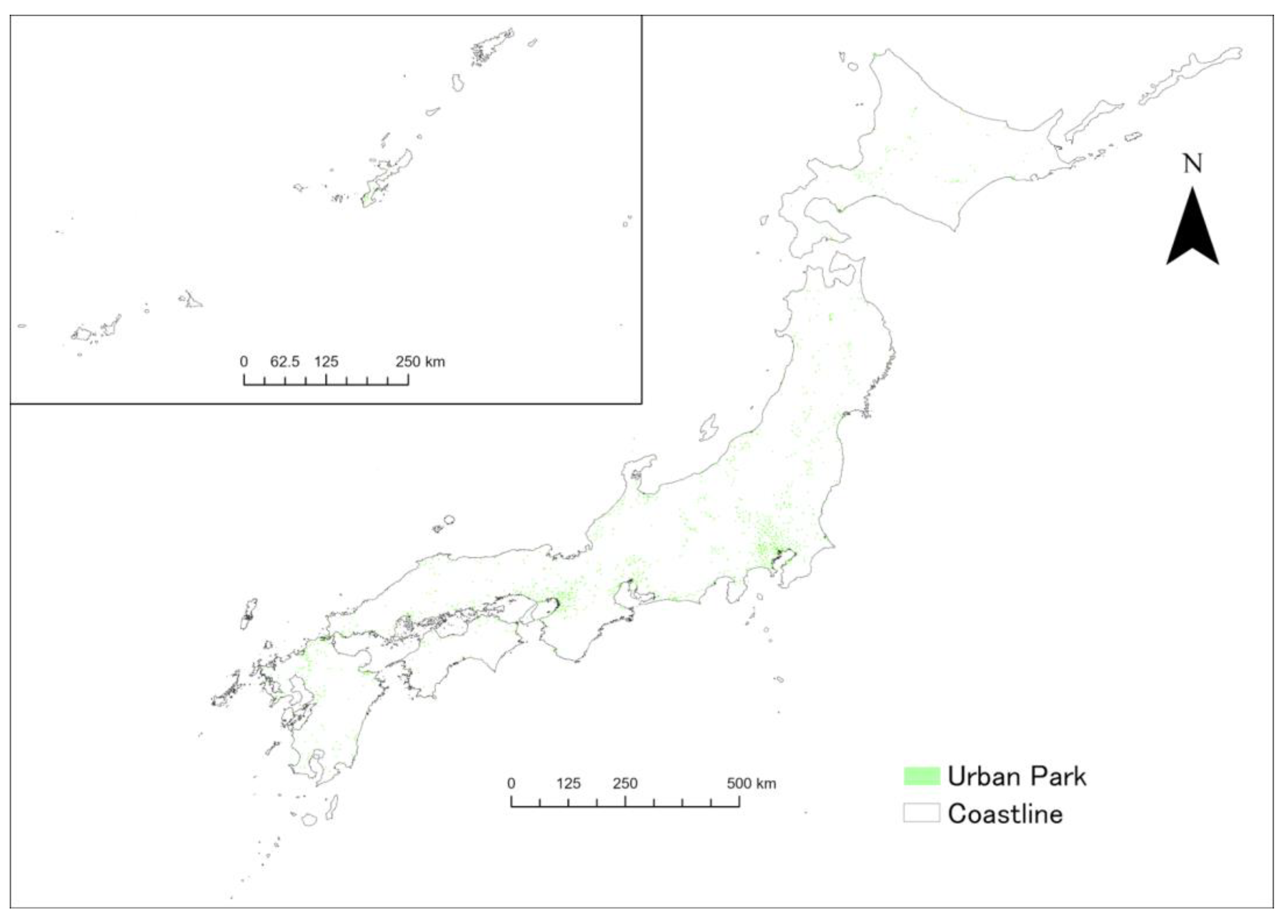
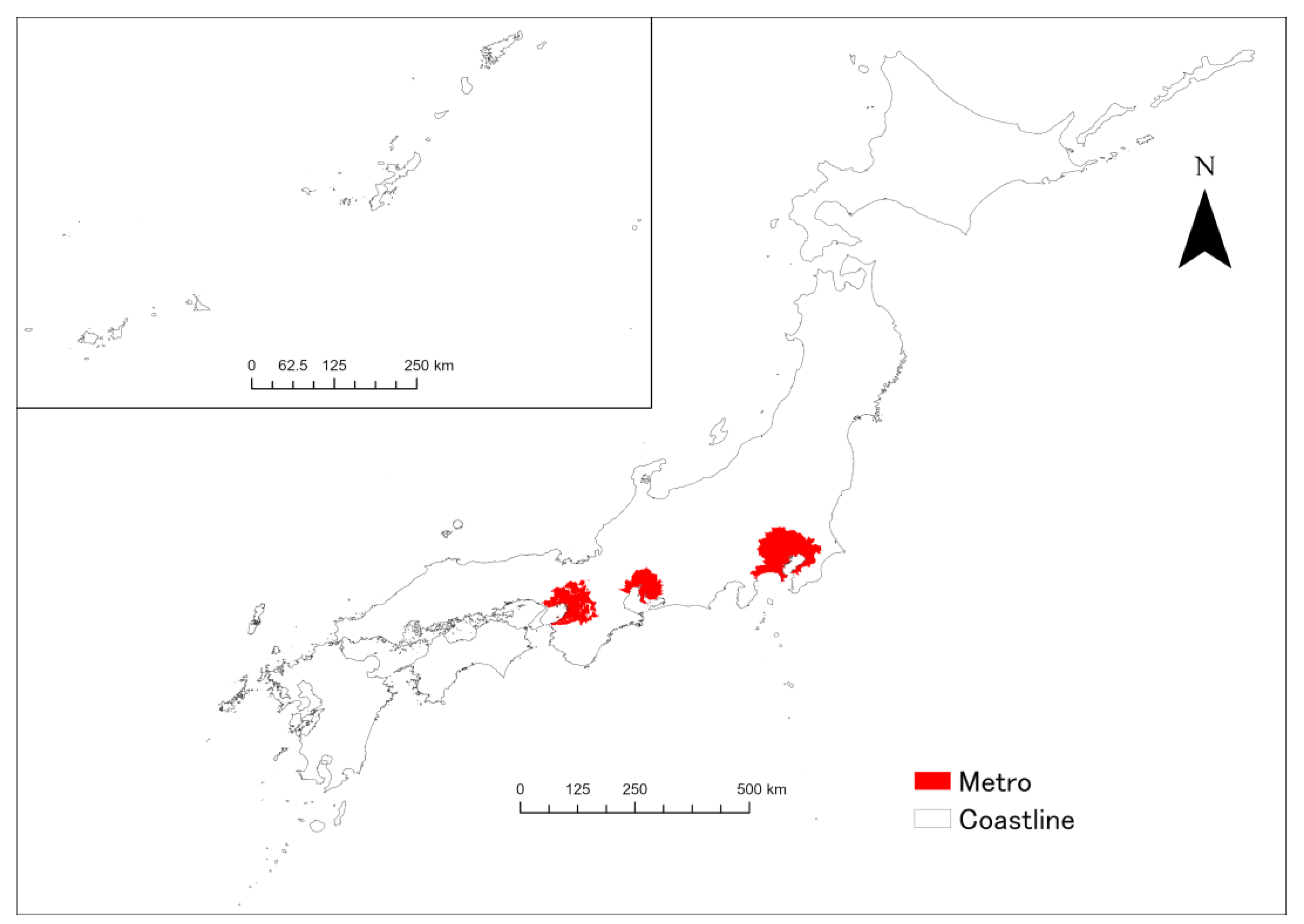


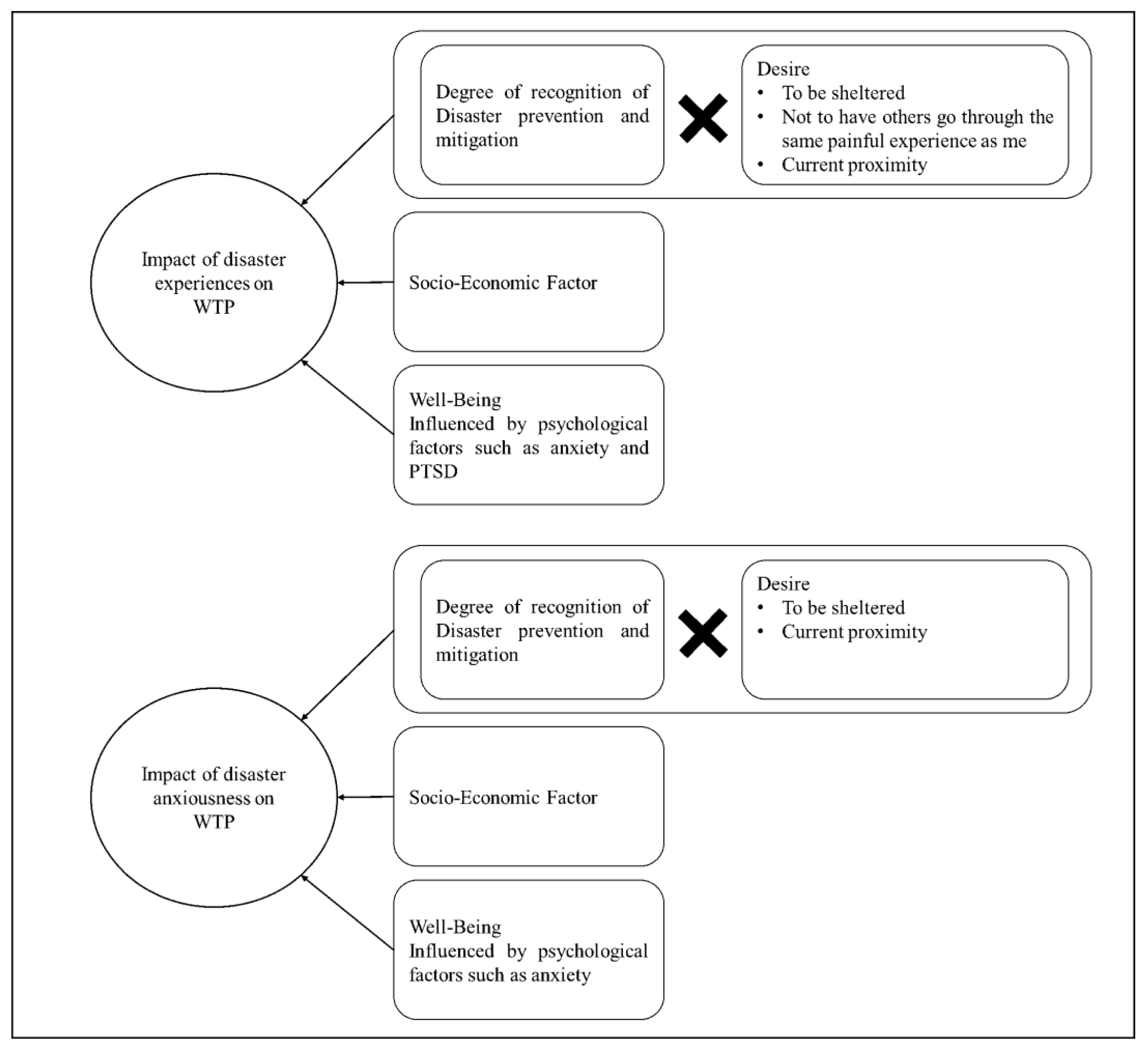
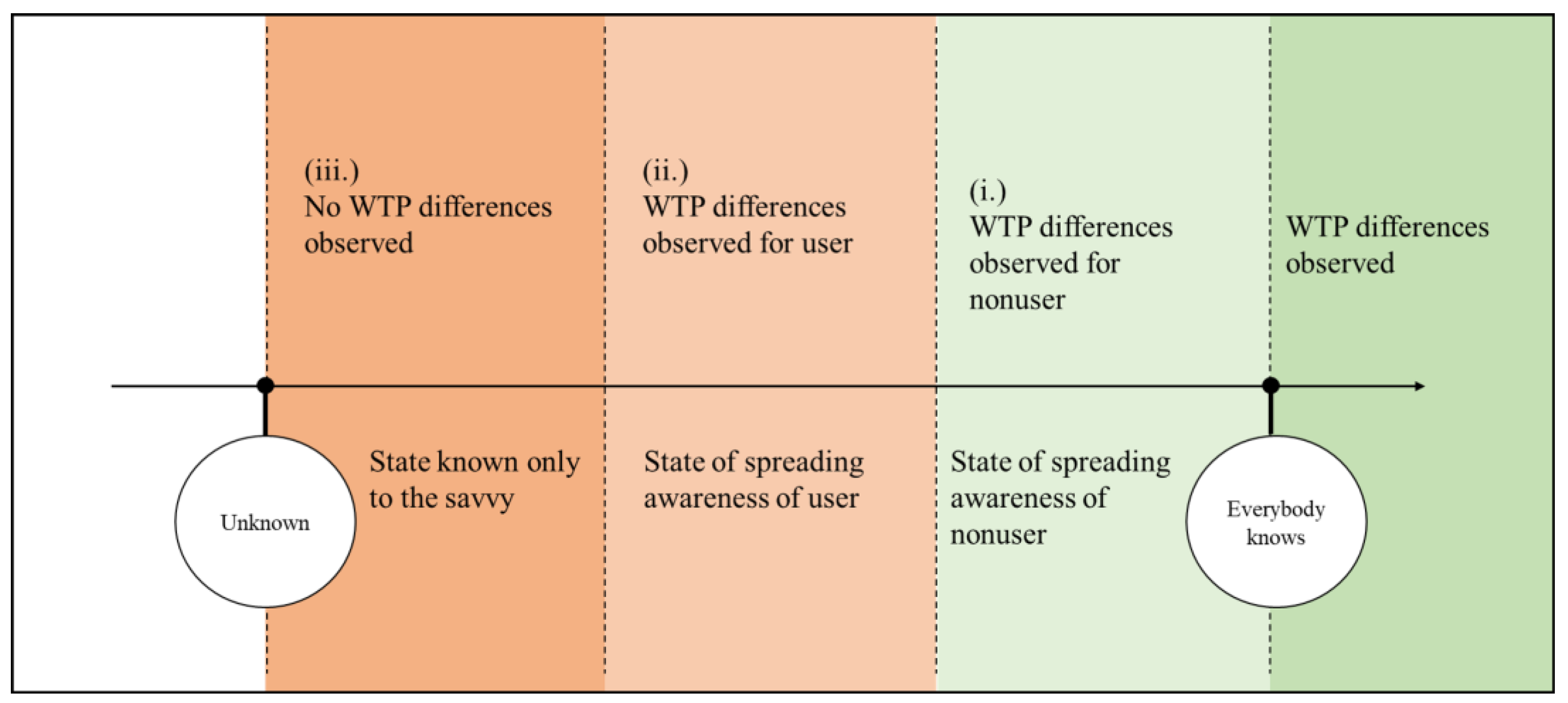
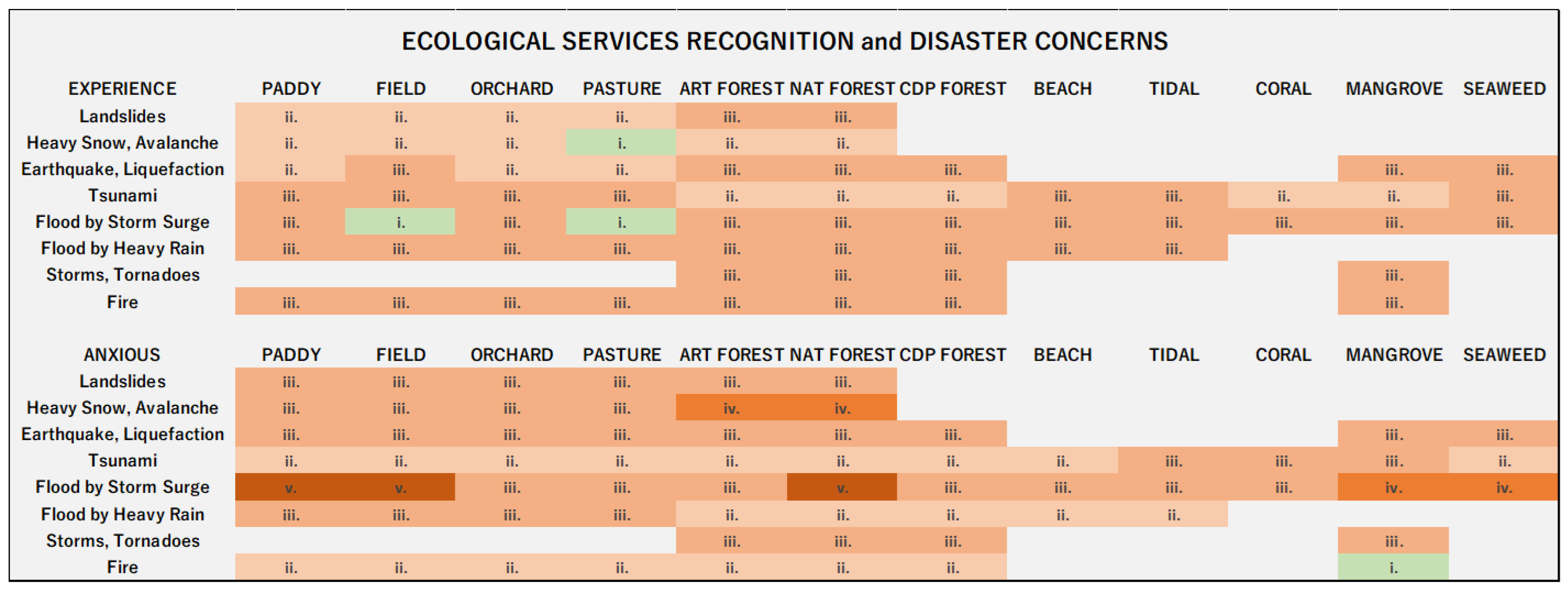
| WTP 0/1T/2T/5T | Paddy Field | Crop Field | Orchard | Pasture Land | Artificial Forest | Natural Forest | CDP Forest | Coral Reef | Mangrove Forest | Seaweed Bed | Tidal Flat | Beach |
|---|---|---|---|---|---|---|---|---|---|---|---|---|
| Socio-Economic Factor | ||||||||||||
| Household Income | 0.143 *** | 0.158 *** | 0.137 *** | 0.133 *** | 0.149 *** | 0.186 *** | 0.154 *** | 0.156 *** | 0.156 *** | 0.161 *** | 0.175 *** | 0.150 *** |
| (0.034) | (0.034) | (0.034) | (0.034) | (0.034) | (0.034) | (0.034) | (0.034) | (0.034) | (0.034) | (0.034) | (0.034) | |
| Sex (male = 1, female = 0) | −0.365 *** | −0.400 *** | −0.397 *** | −0.418 *** | −0.403 *** | −0.367 *** | −0.420 *** | −0.454 *** | −0.454 *** | −0.438 *** | −0.419 *** | −0.328 *** |
| (0.059) | (0.059) | (0.059) | (0.060) | (0.060) | (0.060) | (0.060) | (0.059) | (0.060) | (0.060) | (0.060) | (0.060) | |
| Age | −0.037 | −0.034 | −0.050 | −0.04 | 0.052 | 0.034 | 0.040 | 0.049 | 0.059 * | 0.045 | 0.052 | 0.055 * |
| (0.027) | (0.027) | (0.027) | (0.028) | (0.027) | (0.027) | (0.027) | (0.027) | (0.027) | (0.028) | (0.028) | (0.028) | |
| Family size | 0.054 | 0.049 | 0.032 | 0.043 | 0.000 | −0.012 | −0.012 | 0.009 | 0.015 | −0.008 | −0.018 | 0.003 |
| (0.029) | (0.029) | (0.029) | (0.029) | (0.029) | (0.029) | (0.029) | (0.029) | (0.029) | (0.029) | (0.029) | (0.029) | |
| Number of Children | 0.007 | 0.018 | 0.043 | 0.014 | 0.017 | 0.010 | 0.015 | 0.013 | 0.020 | 0.030 | 0.057 | 0.040 |
| (0.044) | (0.044) | (0.044) | (0.044) | (0.044) | (0.044) | (0.044) | (0.044) | (0.044) | (0.044) | (0.044) | (0.044) | |
| Graduate University | 0.258 *** | 0.224 *** | 0.210 *** | 0.161 ** | 0.261 *** | 0.285 *** | 0.248 *** | 0.233 *** | 0.227 *** | 0.238 *** | 0.205 *** | 0.220 *** |
| (0.060) | (0.060) | (0.060) | (0.060) | (0.060) | (0.060) | (0.060) | (0.060) | (0.060) | (0.060) | (0.061) | (0.060) | |
| Spatial Factor | ||||||||||||
| Live in Megalopolis | −0.170 * | −0.058 | −0.016 | −0.030 | −0.177 * | −0.102 | −0.091 | −0.097 | −0.112 | −0.113 | −0.126 | −0.128 |
| (0.068) | (0.071) | (0.072) | (0.072) | (0.077) | (0.077) | (0.077) | (0.068) | (0.066) | (0.069) | (0.067) | (0.066) | |
| Distance to Target ecosystem | 0.050 | −0.084 * | −0.080 * | −0.087 ** | 0.004 | −0.030 | −0.040 | 0.011 | 0.042 | −0.084 * | 0.054 | 0.003 |
| (0.030) | (0.033) | (0.033) | (0.033) | (0.036) | (0.036) | (0.036) | (0.033) | (0.032) | (0.038) | (0.036) | (0.039) | |
| Distance to Substitute | −0.033 | −0.037 | −0.048 | −0.043 | −0.010 | 0.009 | −0.013 | 0.000 | −0.007 | 0.047 | −0.019 | 0.019 |
| (0.030) | (0.030) | (0.030) | (0.030) | (0.030) | (0.030) | (0.030) | (0.030) | (0.032) | (0.040) | (0.033) | (0.040) | |
| Usage Factor | ||||||||||||
| User | 0.496 *** | 0.583 *** | 0.539 *** | 0.539 *** | 0.639 *** | 0.745 *** | 0.694 *** | 0.627 *** | 0.665 *** | 0.527 *** | 0.595 *** | 0.700 *** |
| (0.067) | (0.071) | (0.062) | (0.058) | (0.062) | (0.063) | (0.062) | (0.070) | (0.083) | (0.075) | (0.065) | (0.062) | |
| Disaster Factor | ||||||||||||
| Experience of Storms, Tornadoes | 0.083 | 0.069 | −0.004 | −0.031 | 0.046 | 0.136 | 0.100 | 0.073 | 0.079 | −0.078 | −0.108 | −0.085 |
| (0.091) | (0.091) | (0.092) | (0.092) | (0.092) | (0.092) | (0.093) | (0.092) | (0.093) | (0.093) | (0.093) | (0.093) | |
| Experience of Flood by Heavy Rain | 0.089 | 0.117 | 0.044 | −0.019 | −0.085 | 0.036 | 0.047 | −0.072 | −0.135 | 0.063 | 0.068 | 0.093 |
| (0.099) | (0.099) | (0.100) | (0.101) | (0.102) | (0.101) | (0.101) | (0.102) | (0.102) | (0.101) | (0.101) | (0.101) | |
| Experience of Landslides | 0.453 * | 0.431 * | 0.593 ** | 0.556 ** | 0.346 | 0.345 | 0.359 | 0.596 ** | 0.577 ** | 0.548 ** | 0.568 ** | 0.578 ** |
| (0.196) | (0.198) | (0.198) | (0.198) | (0.199) | (0.200) | (0.202) | (0.203) | (0.200) | (0.204) | (0.205) | (0.206) | |
| Experience of Heavy Snow, Avalanches | 0.466 *** | 0.438 *** | 0.372 ** | 0.359 ** | 0.396 ** | 0.491 *** | 0.465 *** | 0.401 *** | 0.432 *** | 0.362 ** | 0.367 ** | 0.370 ** |
| (0.121) | (0.120) | (0.121) | (0.121) | (0.122) | (0.120) | (0.120) | (0.119) | (0.120) | (0.121) | (0.123) | (0.122) | |
| Experience of Flood by Storm Surge | 0.011 | −0.001 | 0.041 | 0.169 | −0.209 | −0.293 | −0.305 | −0.340 | −0.291 | 0.067 | −0.042 | −0.370 |
| (0.343) | (0.350) | (0.346) | (0.349) | (0.345) | (0.343) | (0.340) | (0.341) | (0.338) | (0.346) | (0.345) | (0.352) | |
| Experience of Earthquake, Liquefaction | 0.105 | 0.115 | 0.128 | 0.154 | 0.115 | 0.122 | 0.116 | 0.157 | 0.158 | 0.169 * | 0.184 * | 0.209 * |
| (0.083) | (0.083) | (0.083) | (0.083) | (0.084) | (0.084) | (0.084) | (0.083) | (0.084) | (0.084) | (0.085) | (0.085) | |
| Experience of Tsunami | 0.191 | 0.326 | 0.378 | 0.228 | 0.410 | 0.523 * | 0.666 ** | 0.380 | 0.540 * | 0.377 | 0.308 | 0.281 |
| (0.222) | (0.222) | (0.223) | (0.225) | (0.221) | (0.223) | (0.223) | (0.220) | (0.224) | (0.225) | (0.226) | (0.229) | |
| Experience of Fire | 0.345 | 0.418 | 0.353 | 0.326 | 0.298 | 0.121 | 0.168 | 0.371 | 0.271 | 0.248 | 0.262 | 0.177 |
| (0.220) | (0.224) | (0.225) | (0.226) | (0.223) | (0.223) | (0.226) | (0.223) | (0.228) | (0.224) | (0.229) | (0.226) | |
| Anxious of Storms, Tornadoes | 0.020 | 0.012 | 0.035 | 0.039 | −0.061 | −0.091 | −0.017 | −0.001 | 0.013 | 0.003 | 0.011 | 0.009 |
| (0.066) | (0.066) | (0.066) | (0.066) | (0.066) | (0.066) | (0.066) | (0.066) | (0.066) | (0.066) | (0.067) | (0.066) | |
| Anxious of Flood by Heavy Rain | 0.040 | 0.038 | 0.074 | 0.062 | 0.119 | 0.131 | 0.142 * | 0.095 | 0.139 * | 0.168 * | 0.117 | 0.133 |
| (0.068) | (0.069) | (0.069) | (0.069) | (0.069) | (0.069) | (0.069) | (0.069) | (0.069) | (0.069) | (0.069) | (0.069) | |
| Anxious of Landslides | −0.027 | −0.005 | −0.068 | −0.077 | −0.010 | −0.054 | −0.052 | −0.031 | −0.038 | −0.051 | −0.071 | −0.073 |
| (0.073) | (0.073) | (0.073) | (0.074) | (0.073) | (0.073) | (0.073) | (0.074) | (0.074) | (0.074) | (0.074) | (0.074) | |
| Anxious of Heavy Snow, Avalanches | −0.116 | −0.119 | −0.069 | −0.132 | −0.263 *** | −0.305 *** | −0.293 *** | −0.345 *** | −0.352 *** | −0.323 *** | −0.291 *** | −0.239 ** |
| (0.078) | (0.078) | (0.078) | (0.079) | (0.079) | (0.079) | (0.079) | (0.083) | (0.083) | (0.081) | (0.084) | (0.080) | |
| Anxious of Flood by Storm Surge | −0.248 * | −0.223 * | −0.152 | −0.196 | −0.126 | −0.253 * | −0.157 | −0.156 | −0.136 | −0.225 * | −0.165 | −0.084 |
| (0.101) | (0.101) | (0.101) | (0.102) | (0.101) | (0.101) | (0.101) | (0.102) | (0.102) | (0.102) | (0.102) | (0.102) | |
| Anxious of Earthquake, Liquefaction | −0.047 | −0.012 | 0.019 | 0.009 | −0.007 | 0.031 | 0.040 | 0.038 | 0.06 | −0.037 | 0.018 | 0.000 |
| (0.066) | (0.066) | (0.066) | (0.067) | (0.066) | (0.066) | (0.066) | (0.066) | (0.066) | (0.067) | (0.067) | (0.067) | |
| Anxious of Tsunami | 0.161 | 0.181 * | 0.150 | 0.222 * | 0.154 | 0.209 * | 0.259 ** | 0.135 | 0.127 | 0.195 * | 0.148 | 0.178 |
| (0.088) | (0.088) | (0.089) | (0.089) | (0.089) | (0.089) | (0.088) | (0.091) | (0.091) | (0.091) | (0.091) | (0.091) | |
| Anxious of Fire | 0.262 *** | 0.221 ** | 0.167 * | 0.203 ** | 0.217 ** | 0.272 *** | 0.211 ** | 0.252 *** | 0.240 *** | 0.264 *** | 0.243 *** | 0.167 * |
| (0.070) | (0.070) | (0.070) | (0.071) | (0.070) | (0.070) | (0.070) | (0.070) | (0.070) | (0.070) | (0.070) | (0.070) | |
| cut1 (WTP = 0 JPY) | −0.176 * | −0.079 | −0.119 | −0.193 * | −0.237 ** | −0.361 *** | −0.255 ** | −0.552 *** | −0.450 *** | −0.491 *** | −0.458 *** | −0.168 * |
| (0.089) | (0.092) | (0.085) | (0.080) | (0.084) | (0.084) | (0.084) | (0.077) | (0.076) | (0.077) | (0.077) | (0.084) | |
| cut2 (WTP = 1000 JPY) | 1.807 *** | 1.917 *** | 1.891 *** | 1.865 *** | 1.893 *** | 1.917 *** | 1.942 *** | 1.587 *** | 1.643 *** | 1.657 *** | 1.722 *** | 1.993 *** |
| (0.093) | (0.097) | (0.090) | (0.085) | (0.089) | (0.090) | (0.090) | (0.081) | (0.081) | (0.081) | (0.082) | (0.089) | |
| cut3 (WTP = 2000 JPY) | 2.667 *** | 2.781 *** | 2.791 *** | 2.751 *** | 2.860 *** | 2.849 *** | 2.871 *** | 2.504 *** | 2.593 *** | 2.618 *** | 2.707 *** | 2.956 *** |
| (0.099) | (0.103) | (0.097) | (0.093) | (0.097) | (0.096) | (0.097) | (0.088) | (0.089) | (0.090) | (0.091) | (0.098) | |
| cut4 (WTP = 5000 JPY) | 3.484 *** | 3.615 *** | 3.692 *** | 3.587 *** | 3.705 *** | 3.734 *** | 3.742 *** | 3.411 *** | 3.441 *** | 3.494 *** | 3.586 *** | 3.867 *** |
| (0.111) | (0.114) | (0.112) | (0.108) | (0.111) | (0.109) | (0.110) | (0.104) | (0.105) | (0.107) | (0.109) | (0.114) | |
| AIC | 11,246.96 | 11,181.69 | 10,958.99 | 10,736.29 | 10,902.97 | 11,102.43 | 11,014.94 | 10,987.68 | 10,819.83 | 10,712.78 | 10,647.15 | 10,799.28 |
| N | 4428 | 4427 | 4416 | 4416 | 4433 | 4438 | 4430 | 4418 | 4414 | 4405 | 4406 | 4413 |
| WTP 0/1T/2T/5T | Paddy Field | Crop Field | Orchard | Pasture Land | Artificial Forest | Natural Forest | CDP Forest | Coral Reef | Mangrove Forest | Seaweed Bed | Tidal Flat | Beach |
|---|---|---|---|---|---|---|---|---|---|---|---|---|
| User | ||||||||||||
| Live in Megalopolis Dummy | −0.123 | −0.011 | 0.077 | 0.156 | 0.005 | 0.117 | 0.110 | 0.151 | 0.352 * | −0.008 | 0.289 * | 0.090 |
| (0.082) | (0.081) | (0.088) | (0.100) | (0.092) | (0.092) | (0.092) | (0.127) | (0.164) | (0.147) | (0.119) | (0.079) | |
| Distance to Target ecosystem | 0.030 | −0.077 * | −0.055 | −0.077 | −0.040 | −0.081 | −0.105 * | −0.099 | −0.118 | 0.064 | 0.047 | −0.070 |
| (0.042) | (0.038) | (0.041) | (0.046) | (0.044) | (0.044) | (0.044) | (0.081) | (0.095) | (0.087) | (0.072) | (0.049) | |
| Distance to Substitute | −0.03 | −0.033 | −0.078 * | −0.111 ** | −0.030 | −0.009 | −0.045 | −0.068 | 0.022 | −0.143 | −0.102 | 0.003 |
| (0.033) | (0.033) | (0.037) | (0.042) | (0.035) | (0.035) | (0.035) | (0.065) | (0.086) | (0.091) | (0.068) | (0.051) | |
| Nonuser | ||||||||||||
| Live in Megalopolis Dummy | −0.304 ** | −0.258 | −0.206 | −0.214 * | −0.523 *** | −0.512 *** | −0.469 *** | −0.180 * | −0.191 ** | −0.144 | −0.306 *** | −0.551 *** |
| (0.116) | (0.135) | (0.114) | (0.097) | (0.125) | (0.124) | (0.125) | (0.078) | (0.071) | (0.077) | (0.079) | (0.107) | |
| Distance to Target ecosystem | 0.049 | −0.128 | −0.144 * | −0.100 * | 0.070 | 0.044 | 0.059 | 0.027 | 0.056 | −0.120 ** | 0.053 | 0.131 * |
| (0.047) | (0.068) | (0.058) | (0.049) | (0.059) | (0.059) | (0.059) | (0.036) | (0.034) | (0.043) | (0.042) | (0.065) | |
| Distance to Substitute | −0.012 | −0.033 | 0.025 | 0.048 | 0.059 | 0.076 | 0.093 | 0.019 | −0.007 | 0.088 * | −0.001 | −0.008 |
| (0.075) | (0.083) | (0.053) | (0.046) | (0.058) | (0.059) | (0.059) | (0.034) | (0.034) | (0.044) | (0.038) | (0.065) |
Disclaimer/Publisher’s Note: The statements, opinions and data contained in all publications are solely those of the individual author(s) and contributor(s) and not of MDPI and/or the editor(s). MDPI and/or the editor(s) disclaim responsibility for any injury to people or property resulting from any ideas, methods, instructions or products referred to in the content. |
© 2023 by the authors. Licensee MDPI, Basel, Switzerland. This article is an open access article distributed under the terms and conditions of the Creative Commons Attribution (CC BY) license (https://creativecommons.org/licenses/by/4.0/).
Share and Cite
Komatsubara, K.; Keeley, A.R.; Managi, S. Revisiting the Value of Various Ecosystems: Considering Spatiality and Disaster Concern. Sustainability 2023, 15, 3154. https://doi.org/10.3390/su15043154
Komatsubara K, Keeley AR, Managi S. Revisiting the Value of Various Ecosystems: Considering Spatiality and Disaster Concern. Sustainability. 2023; 15(4):3154. https://doi.org/10.3390/su15043154
Chicago/Turabian StyleKomatsubara, Kento, Alexander Ryota Keeley, and Shunsuke Managi. 2023. "Revisiting the Value of Various Ecosystems: Considering Spatiality and Disaster Concern" Sustainability 15, no. 4: 3154. https://doi.org/10.3390/su15043154






